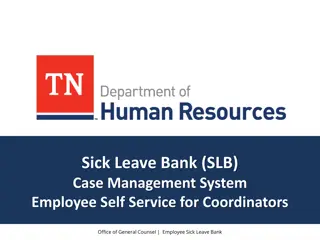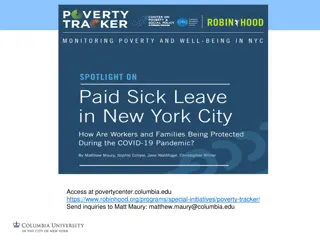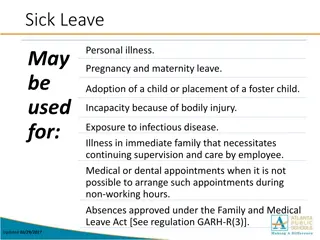Oregon Sick Time Law
This overview covers the key aspects of Oregon's Sick Time Law, including accrual, paid vs. unpaid sick time, minimum wage rates, and compliance requirements for employers. The law outlines provisions for accruing sick time, usage eligibility, and metro-urban distinctions affecting wage rates. Employers with existing PTO policies are also addressed in relation to the law's minimum requirements.
Download Presentation

Please find below an Image/Link to download the presentation.
The content on the website is provided AS IS for your information and personal use only. It may not be sold, licensed, or shared on other websites without obtaining consent from the author.If you encounter any issues during the download, it is possible that the publisher has removed the file from their server.
You are allowed to download the files provided on this website for personal or commercial use, subject to the condition that they are used lawfully. All files are the property of their respective owners.
The content on the website is provided AS IS for your information and personal use only. It may not be sold, licensed, or shared on other websites without obtaining consent from the author.
E N D
Presentation Transcript
Oregon Sick Time Law https://www.pyramidtimesystems.com/Customer-Content/WWW/CMS/images/Paid_Sick.jpg
Trends in implementation of working conditions laws in Oregon Adoption of local ordinances precursors to state law, e.g., minimum wage rates, sick leave, work schedules Multiple legislative sessions before passing Distinctions between urban and non-urban areas, e.g., employee thresholds; different provisions (wage rates, paid v. unpaid sick time)
Paid v. Unpaid Sick Time Employers with 10 or more employees (6 or more if the employer is located in Portland) must pay employees for sick time. All other employers must provide unpaid sick time.
Metro Urban Growth Boundary Region 2 $9.25 Nonurban counties Region 3 Standard Region 1 Oregon Minimum Wage Rates January 1, 2016 $9.25 $9.25 July 1, 2016 $9.75 $9.75 $9.50 July 1, 2017 $10.25 $11.25 $10.00 July 1, 2018 $10.75 $12.00 $10.50 July 1, 2019 $11.25 $12.50 $11.00 July 1, 2020 $12.00 $13.25 $11.50 July 1, 2021 $12.75 $14.00 $12.00 July 1, 2022 $13.50 $14.75 $12.50 July 1, 2023 Adjusted annually based on the increase, if any, to the US City average Consumer Price Index for All Urban Consumers $1.25 over the standard minimum wage $1 less than the standard minimum wage
Requirements of Oregons Sick Time Law: Accrual Employees begin accruing sick time on the first day of employment Employees earn one hour of sick time for every 30 hours or 1 1/3 hours for every 40 hours worked* Employees may use accrued sick time after 90 days of employment Employers may front load 40 hours of sick time at the beginning of the year rather than track sick time hours accrued *FLSA exempt employees paid on a salary basis are presumed to work 40 hours each work week for purposes of accruing Oregon Sick Time unless the actual work week is less than 40 hours, in which case Oregon Sick Time accrues based on the actual work week. Friday, February 14, 2025
Existing PTO, vacation plans Employers with a sick leave policy, vacation policy, paid personal time off or other paid time off program that is substantially equivalent to the minimum requirements of Oregon Sick Time are deemed to in compliance with the law.
Employee Exceptions The following are not employees: Employees receiving paid sick time under federal law Independent Contractors Work Training participants Work-Study participants Railroad Workers I Individuals employed by the individual s parent, spouse or child.
Qualifying Absences An employee may use Oregon Sick Leave for the diagnosis, care, or treatment of the employee or the employee s family member s mental or physical illness, injury, or health condition. Diagnosis, care or treatment, includes preventive (routine medical/dental visits) Family member s diagnosis, care or treatment, includes preventive All OFLA covered absences Domestic violence, harassment, sexual assault or stalking Public health emergencies which closes school, work or child care
Family Members Family Member with Oregon Sick Time is the same as Oregon Family Leave Act Spouse Same-gender domestic partner Custodial parent Non-custodial parent Adoptive parent Foster parent Biological parent Stepparent Parent in law Parent of employee s same-gender domestic partner Stepchild Child of same gender domestic partner Grandparent Grandchild In loco parentis Biological child Adopted child Foster child
Family members who are NOT covered: Opposite-sex domestic partners Siblings* Cousins* Aunts and uncles* * EXCEPTIONS for in loco parentis relationships.
Accrual and Carryover Caps An employee begins to earn and accrue sick time on the first day of employment and may carry over up to 40 hours of unused sick time from one year to the next. However, an employer may adopt a policy: Capping accrual at 80 hours Capping 40 hours of sick leave in a year.
Intersection with other Leave Laws OFLA/FMLA: Oregon Sick Time runs concurrently if the employee is eligible for OFLA and/or FMLA and the absence also qualifies under OFLA and/or FMLA
CBA Exemption* The Oregon Sick Time Law does not apply to an employee whose terms and conditions of employment are: a) covered by a collective bargaining agreement, b) who is hired through a hiring hall or similar referral system operated by the labor organization or a third party, and c) whose employment-related benefits are provided by a joint multi-employer- employee trust or benefit plan. *All three of these criteria must be met for this exemption to apply
Employee Notice Employers may require reasonable advance notice for use of Oregon Sick Time if the leave is foreseeable. If the Oregon Sick Time Leave is unforeseeable the employee needs to provide notice as soon as practicable.
Documentation If an employee takes more than three consecutive scheduled workdays for Oregon Sick Time, an employer may require verification from a health care provider of the need for leave. Medical verification is required to be provided within 15 calendar days. Employer needs to pay for any out of pocket costs, including any lost wages.
Documentation Health Care Providers defined to include: Physician Dentist Psychologist Optometrist Naturopath Registered Nurse Nurse Practitioner Midwife Social Worker Chiropractic Physician
Required Quarterly Employer Notice to Employees Employers are required to provide employees with quarterly written notices of the amount of accrued and unused Oregon Sick Time available for use by the employee. Inclusion of this information in paycheck stubs complies with this requirement.
Employer Notice to Employees Employers are required to provide employees with written notice of the requirements for Oregon Sick Time.
Unlawful Practices: An employer may not: Require an employee to find a replacement or Work an alternate shift to make up the use of sick time (However, upon mutual consent between employer and employee an employee can make up the time they were absent without using sick leave, however, the employer may not require the employee to work additional hours or shifts.) Deny, interfere with, restrain or fail to pay for sick time Retaliate or discriminate against an employee because the employee has: Inquired about; Submitted a request for; or Taken sick time
Safe Harbor Civil Penalties may not be assessed for Oregon Sick Time violations until January 1, 2017.* *Does not cover civil suits























